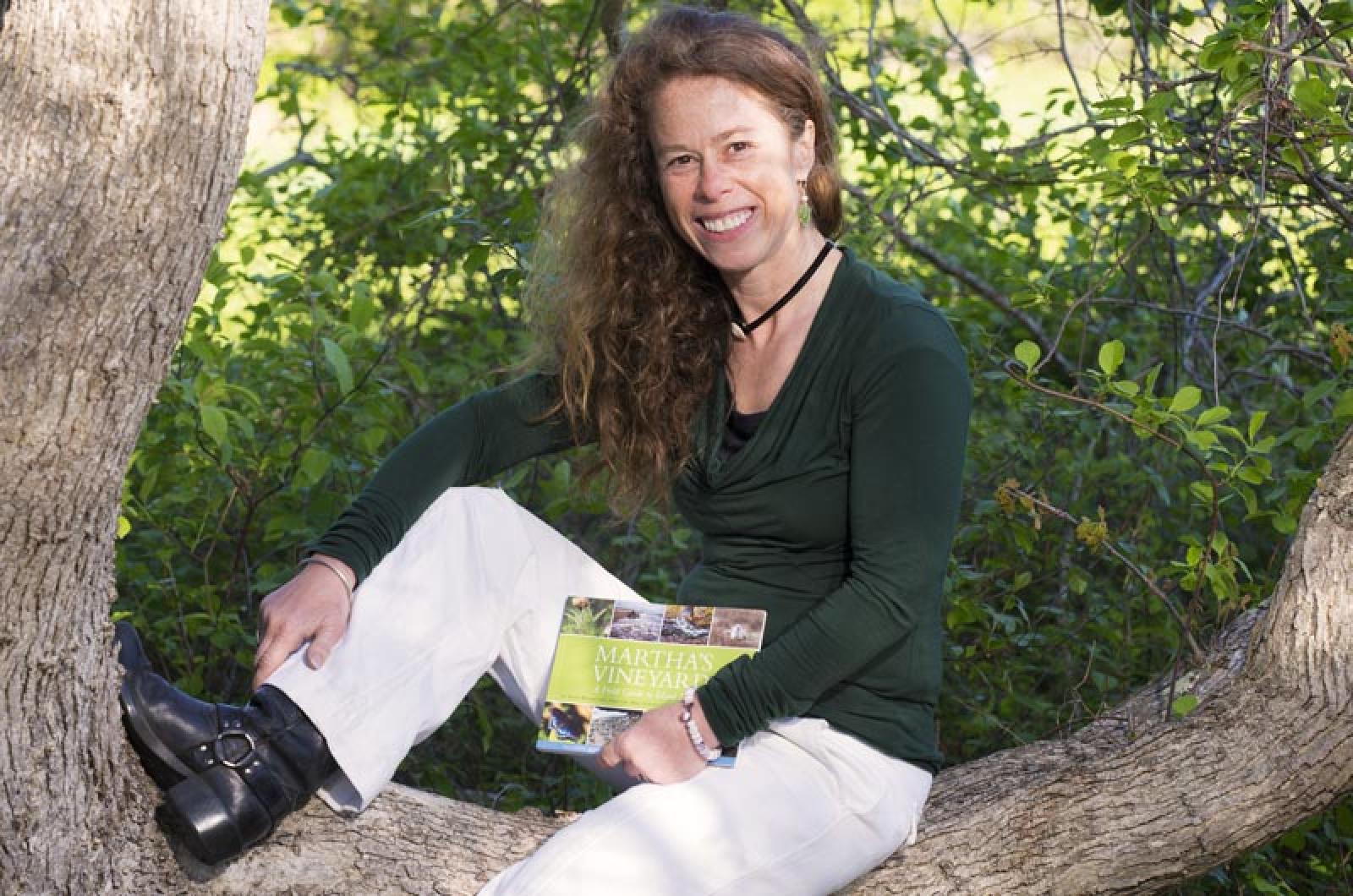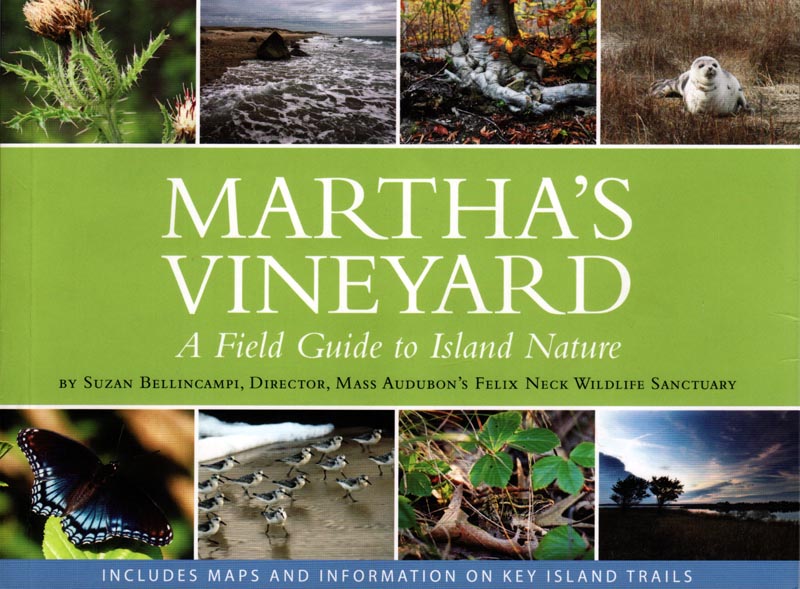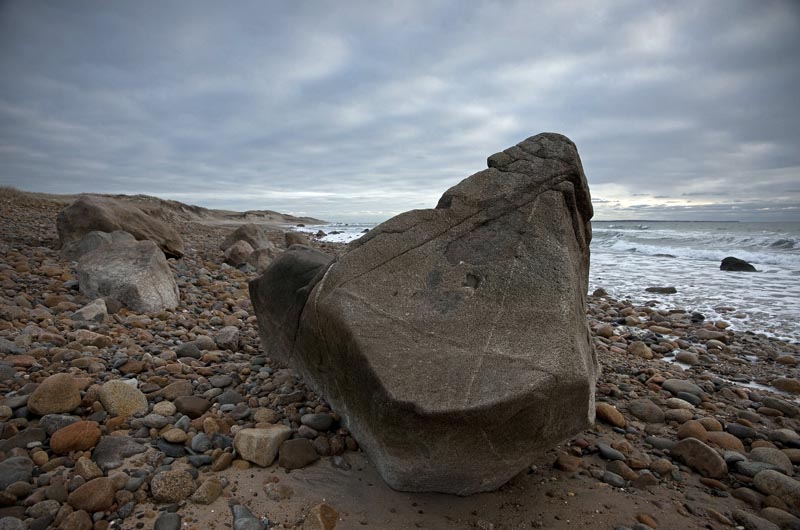There are beetlebung trees and pinkletinks to identify, a heath hen sculpture to find and constantly changing landscapes to behold at either end of the Island. There are bay scallops and horseshoe crabs, sweet gales to see and also plants to avoid. The Vineyard is a place of natural discovery and a new field guide hopes to capture just that.
Martha’s Vineyard: A Field Guide to Island Nature is an updated version of Moraine to Marsh. Written by Anne Hale, that book has been a companion of Vineyard nature enthusiasts since 1988. The new guide was written by Suzan Bellincampi, director of Mass Audubon’s Felix Neck Wildlife Sanctuary in Edgartown. All sales of the book will benefit the sanctuary.
The field guide includes maps by Dana Gaines, drawings by Marcia Wise from the original publication, and photographs by Timothy Johnson and volunteers. The book is dedicated to state forest superintendent John Varkonda, who died unexpectedly earlier this year.
The guide includes a geological history of the Vineyard, types of landscapes found on the Island, six prominent trails and guides to flora and fauna.
The field guide is user-friendly and is made to be earmarked and to develop deep creases in the spine. Ms. Bellincampi said the new field guide is in keeping with the sanctuary’s mission to engage the next generation with their environs.
“It’s teaching people about and to love nature, it’s getting people outside,” she said. “Grab the book and put it in your backpack. That’s why it’s small; it’s meant to be taken out. Hopefully, it’s going to have pine tar and bug smudges on it.”
Mrs. Hale, who died in 1992, was an early member of the Vineyard conservation movement and a founder of Felix Neck. The sanctuary was created in 1968, but Mrs. Hale ran educational programs for five years prior and established the sanctuary’s Fern and Feather day camp for children. This year marks the popular camp’s 50th anniversary.
In the years leading up to the 1988 publication of Moraine to Marsh, Mrs. Hale walked all the corners of the Island and documented her field trips in a series for the Gazette.
Ms. Bellincampi first encountered the book in 1999, when she traveled to the Island for a job interview with what would eventually be her first Vineyard job with The Trustees of Reservations. With the book now out of print, Ms. Bellincampi said it was an important piece of the Vineyard to carry forward.
“We can’t let this book disappear,” she said. “It’s introduced so many people to the Vineyard and to nature; it’s so accessible. It’s really hands on and has great illustrations.”
Ms. Bellincampi and a handful of volunteers set out to literally walk in Mrs. Hale’s footprints to update the book. But they soon discovered that the trails and fields explored by Mrs. Hale more than 25 years ago had changed.
“I had a lot of people go out with this and say they couldn’t find a trail,” Ms. Bellincampi said. “And that’s when I got the sense that it was going to be bigger and have more changes than I had thought. We had people test it before, test it during and test it after.”
For example, the trail in the state forest Mrs. Hale first wrote about was wiped out in 1991 by Hurricane Bob. Ms. Bellincampi worked with Mr. Varkonda on finding the new best route. She particularly wanted to include the heath hen statue, an ode to the extinct bird that sparked the creation of the forest.
“I wanted to choose a route that brings people to the statue. It’s really unique and really special,” she said.
There were other changes, too. Some fields Mrs. Hale wrote about are now forest. And back then Aquinnah was still Gay Head.
“She just took people up to Gay Head, that’s all there was,” Ms. Bellincampi said. “And now the [Martha’s Vineyard] land bank has acquired the north head and the south head. She had a couple of properties that still exist but you miss so much if you go to Aquinnah and don’t walk some of those trails.”
The hardest chapter to write was Wasque Point, Ms. Bellincampi said, due to its constantly changing landscape.
“We were trying to figure out how do we lead people through a trail system when the property has changed dramatically,” she said. “Sometimes the trail is here and sometimes the trail is there. What’s happening out there is changing on a daily basis. We worked hard to capture the history of Wasque as one of change.”
One of the biggest challenges was writing directions for a variety of uses.
“You can look at the map and read as you go. You can read before and leave the book at home, but you need to have objects,” she said. “Here’s a fork that didn’t used to be there. How do I keep people going north?”
If a volunteer hiker got lost, Ms. Bellincampi would rework the instructions.
Not all of the great walking trails of the Vineyard are included in the book, but Ms. Bellincampi said she selected the most “emblematic of the Island.”
“If you were to come here on vacation for a week and visit five or six of these properties you would get a really nice slice of what the Vineyard has to offer nature-wise,” she said. “Or if you’ve been here for 20 years, to re-engage with these places is really nice.”
Ms. Bellincampi never met Mrs. Hale, but said she hoped she’d be proud of what the sanctuary and the Island have accomplished.
“I think she would love the idea that we’re still here, still teaching people about nature and still providing these kinds of tools,” she said. “In some ways it’s her legacy of teaching and caring and engaging people in the study of nature, and that’s going to continue.”
A book release party is scheduled for June 14 from 4 p.m. to 6 p.m. at Felix Neck in Edgartown. All are welcome.








Comments (2)
Comments
Comment policy »